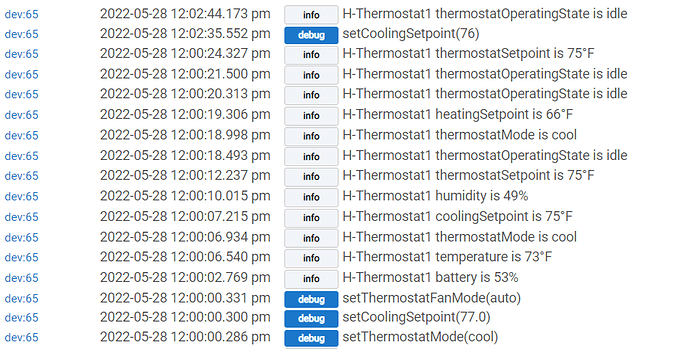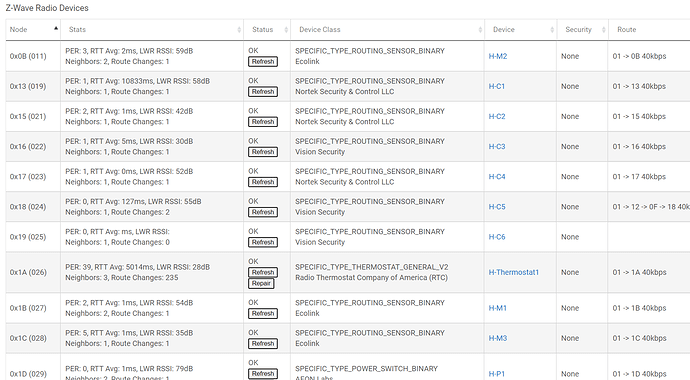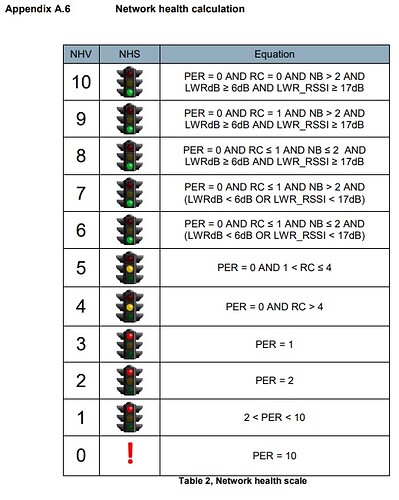I believe that's how it's supposed to work, when you use the Thermostat scheduler to set the setpoints.
As seen in the log, Scheduler DID kick off setting setpoint to 77, but device temperature did NOT change staying at 75. However, it does respond property when I changed it via the Dashboard.
It is buggy and not reliable. Any additional help is appreciated before I sending this thing back to Amazon.
Thank you!
This sounds like a weak mesh. Is this your only Zwave device?
This also appears to be a very old Zwave device. I am not very familiar with this particular device, but many old Zwave (non-plus) do not report their status back to the hub. Not sure if this is one of those that do not report back.
It could be due to a weak mesh. I have a dozen devices connected to this hub for now. I do have other Ring zwave devices controlled by the Ring Alarm security panel. Vera worked ok with the Ring Alarm though.
Line powered, or battery powered?
Could you do a screenshot of the whole Zwave details page?
Make sure you read the details on how Thermostat Controller and Scheduler are desgined to work...you use the scheduler only w/the controlled thermostat, which shows up as a device in your Device list (e.g., "H-Thermostat1 Controller", not w/the actual thermostat device itself. Just wanted to clarify that just in case.
How It Works
Thermostat Controller manipulates the setpoints of the controlled thermostat to control its operation. This usurps most of the functionality of the controlled thermostat. To call for cooling, for example, Thermostat Controller will set the cooling setpoint of the controlled thermostat to a level well below the current temperature, thus forcing the controlled thermostat into cooling operation. The amount by which the setpoint is set below is determined by the Control Offset, a settable number of degrees. When the demand for cooling has been met, the controlled thermostat's cooling setpoint will be set well above the current temperature, thus forcing it to idle, and again using the Control Offset. The Control Offset defaults to 2° F, and should be set high enough to cover any difference between the average temperature of all of the sensors, and the temperature reported by the controlled thermostat itself.
Cautions
Bear in mind that this app usurps the control and most safeguards of the existing thermostat. Avoid setting the Control Offset higher than needed for successful control. The Control Offset should be kept low so that should the hub fail, the real thermostat will not be in a run-away condition. Be careful in establishing a proper Hysteresis setting.
Use with Thermostat Scheduler
To add scheduling to the controller thermostat, it may be selected in Thermostat Scheduler. Do not use Thermostat Scheduler with the controlled thermostat, once it is under control of Thermostat Controller.
I would say you don't have enough repeaters. It appears you have two, and that just isn't enough.

Holy crap that is BAD!!! I don't think I have ever seen one that high before. You have serious issues here.
Here is Zwave's documentation as to what you should be seeing.
(RC is route changes, and NB is Neighbors)
Great info. Thanks. I changed the scheduler to use the controller device instead. For the controller settings, do I need to set the setpoint value for both the H-Thermostat1 and H-Thermostat1 Controller? and should they have the same value? Why both show up with configurable values?
Also device 0X19 could be a ghost or a battery powered device that maybe the battery needs changing?
Thanks for the information. I will pair more wired devices to add neighbor counts, hopefully reducing the routes.
Or it is a battery powered device that has not checked in since the last hub reboot ......
Yes. That is one of the battery powered contact sensors. I will change its battery. Thanks.
Was that your full table? If so, there's something really funky going on because there is no device 0x12 or 0x0F, yet both of those are used in the route for 0x18.
Edit:
So 0x12 and 0x0F should have shown up in your z-wave table that you posted. Because they aren't there, they are probably stranded devices that are seriously interfering with your z-wave mesh. I'll bet the reason you have 200+ route changes on your thermostat (0x1A) is because it is trying to route through these devices that don't exist.
I would strongly recommend you contact @support_team, because there is something seriously awry with your z-wave table. Also tagging some of the z-wave experts in the community for their input: @JasonJoel @lewis.heidrick @csteele @neonturbo @bertabcd1234
Oooh, good catch! Something odd going on there.
Not me! I know enough to be dangerous!
I know enough to know I don't much at all about z-wave ![]() .
.
You know way more than me!
That is the whole current table. I unpaired 6 or 7 devices last night though
At a minimum, I would do a shutdown from the Settings menu. Pull the power plug at the wall, and wait 1 minute. Power back up and give the hub maybe 30 minutes to an hour to settle. From there, see if the table changed any.
I wonder if a Repair on that node that is routing via those missing devices would help? I don't think it could hurt at this point. Hopefully one of the Zwave experts can give further advice here.
Something didn't go right in that process.
Good advice!
Ok. I am doing a Z-Wave Firmware Update now, not sure if that is going to help. After it is done. I will re-pair the devices I unpaired last night and perform a reboot. Will report back with a new table. Thank you, all, for your help!





